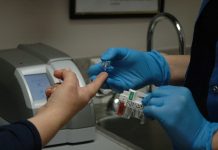A preliminary study suggests that kidney paired donation transplantation, in which incompatible donor/recipient pairs exchange kidneys so that each recipient receives a compatible kidney, had graft survival rates equivalent to compatible live donor transplants, according to a study in the October 5 issue of JAMA.
The number of patients waiting for a kidney transplant continues to increase at an alarming pace and any significant gains in closing the gap between organ supply and demand are likely to come from the increased use of live donors, according to background information in the article. The two most significant barriers to greater use of live donors are blood type incompatibility and human leukocyte antigens (HLA) antigen sensitization. Based on blood group frequencies in the United States, there is a 36 percent probability that any two individuals will be blood type incompatible, eliminating up to one-third of the potential live donor pool. In about 30 percent of the patients on the deceased donor waiting list, HLA antigen sensitization is present due to exposure to foreign tissue in the form of previous transplants, pregnancies, or blood transfusions.
An alternative strategy is kidney paired donation (KPD) transplantations. In KPD transplants, incompatible donor/recipient pairs exchange kidneys so that each recipient receives a compatible organ. The KPD transplant program represents a cost savings compared with desensitization, which is significantly less costly than if an individual continues to undergo dialysis. While logistically challenging, a broader implementation of KPD on a regional or national scale could provide compatible organs for a substantial number of the estimated 6,000 patients on the waiting list who currently have incompatible donors.
Robert A. Montgomery, M.D., D.Phil., of Johns Hopkins University School of Medicine, Baltimore, and colleagues conducted a study to determine the feasibility and effectiveness of KPD for the management of patients with incompatible donors. Paired donations were matched and transplanted from a pool of blood type or crossmatch incompatible donors and recipients with end-stage renal disease (6 conventional and 4 unconventional KPD transplants) between June 2001 and November 2004.
A total of 22 patients received transplants through 10 paired donations including 2 triple exchanges. At a median follow-up of 13 months, the patient survival rate was 100 percent and the graft survival rate was 95.5 percent. Twenty-one of the 22 patients have functioning grafts with a median 6-month serum creatinine level of 1.2 mg/dL. There were no instances of antibody-mediated rejection despite the inclusion of 5 patients who were highly sensitized to HLA antigens due to previous exposure to foreign tissue. Four patients developed acute cellular rejection (18 percent).
Continue Reading Below ↓↓↓
The complexity and potential benefits of an unconventional KPD transplant are demonstrated by the triple exchange. Based on blood type and HLA antigen antibody reactivity, the probability of finding a suitable donor in the deceased donor pool for each of the 3 recipients was 0.029, 0.033 and 0.008.
"This study demonstrates that KPD transplants can be performed with outcomes similar to compatible living donor kidney transplants. The cost savings and decrease in waiting time that could be realized by a wider application of this concept are substantial. Because the likelihood of finding a suitable match is dependent on the size of the pool, a national list could enable many more transplants. We estimate that about half of the incompatible pairs could receive transplants using a national KPD transplant scheme with blood type compatible, negative crossmatch kidneys, including as many as 14 percent of the highly sensitized patients," the authors write.
"Patients unable to be matched by KPD could undergo desensitization with their intended donor. Those who were not deemed acceptable for desensitization due to high titer or immunologic risk could participate in a less restricted KPD search in which a more favorable, but not completely compatible, donor could be identified. This single center experience demonstrates that KPD is feasible, successful, and if applied to larger donor pools capable of expanding access to renal transplantation," the researchers conclude.
(JAMA.2005; 294:1655-1663)
The Importance of Innovative Efforts to Increase Organ Donation
In an accompanying editorial, Arthur J. Matas, M.D., and David E. R. Sutherland, M.D., Ph.D., of the University of Minnesota, Minneapolis, examine the findings by Montgomery et al.
"The individual organ recipients who undergo a successful transplantation have greatly improved expectations compared with those individuals who continue to undergo dialysis. Removing candidates from the transplant waiting list shortens the waiting time for the remainder of patients. One of the limitations of paired exchange is the small number of eligible donor/recipient pairs at each center, making finding a matched pair difficult. Regional or national matching programs would make finding pairs more probable, but including the highly sensitized blood type O candidates would require extensive laboratory testing."
"However, there are several important cautions. While transplant physicians see the tremendous benefit that organ recipients derive from a successful transplant, organ transplantation raises numerous ethical issues involving protection of the donor, informed consent, and equity in organ allocation. To date, only a limited number of long-term outcome and quality-of-life follow-up studies have been performed concerning conventional donors. Paired exchange leads to additional concerns. For example, what if one kidney fails early but the other functions well? Those involved in such programs must pay careful attention to the informed consent process and should be conducting formal follow-up studies of donors."
"Kidney transplantation remains a success story, but its promise and future continue to be threatened by the ongoing lack of suitable organ donors. While new methods to overcome this problem are welcome, the transplant community must face up to the new ethical issues that surround every advance," the authors conclude.
(JAMA.2005; 294:1692-1693.)
Continue Reading Below ↓↓↓
Source: JAMA and Archives Journals










